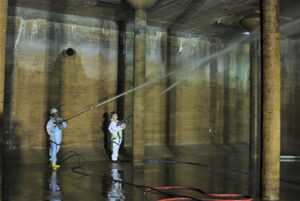
What’s the difference between wet blasting and dry blasting? Let’s see!
There are all kinds of blasting methods used for cleaning, resurfacing, and exposing different materials in industrial capacities. Two main types would be dry blasting and wet blasting, or, to be more specific, dry abrasive blasting and water jet blasting or water abrasive blasting. What is the consensus on dry blasting vs. wet blasting in construction? Let’s take a look at both.
What Is Dry Abrasive Blasting?
Dry abrasive blasting removes or cleans surfaces by blasting dry, small materials at them. These materials include sand, recycled plastic bits, glass beads, nut shells, and bits of steel or other metals. The almost microscopic grits uniformly scrape off dirt, paint, and other unwanted materials. Dry abrasive blasting is helpful for treating concrete, masonry, and metal surfaces.
Pros and Cons
The benefits of dry blasting are as follows:
- More affordable than wet blasting: There is less setup, equipment, and waste containment required.
- Highly effective in uniformly scraping off unwanted surfaces from metal, concrete, and masonry. The tiny sharp edges do the job.
The cons of dry blasting include:
- More dust: Dry blasting is a very dusty job that can harm someone’s lungs if inhaled. Workers mitigate this risk with PPE. Water jet blasting operators also wear PPE for safety.
- Possibility of explosions: Depending on the environment, the dry blasting materials and elements in the air could cause the dust to spark and cause explosions. If sparks are possible, the workers must prepare beforehand to eliminate the risk.
What Is Water Jet Blasting?
Water jet blasting uses high-pressured water and specialized nozzles to blast through paint, rust, dirt, clinker, and much more from concrete, masonry, and metal surfaces. Wet abrasive blasting combines dry abrasives with high-pressurized water, but water jet blasting uses water alone. Various nozzles and water pressures can create the exact impact needed to remove the unwanted substances. Water jet blasting is highly useful in cleaning sewer systems, tanks, and ships.
Pros and Cons
What are the benefits of wet blasting?
- Cleanness without damage: Pressurized water cleans surfaces without damaging the surface; it is all about using the right pressure.
- Cost-effective and safe options: Jet Blast Inc. delivers affordable, professional water blasting services while maintaining safety practices.
Are there any cons to wet blasting?
- Higher water consumption: High water usage can be a problem where water is scarce. However, filtered water from water jet blasting can be recycled.
- More to clean up: Water jet blasting and vacuuming involves containing and disposing of water and dirt. Thankfully, Jet Blast Inc. makes it easy.
Contact Jet Blast Inc. Today!
Jet Blast® Industrial Services strives every day in an effort to provide our customers with the best service and equipment possible. Providing a safe and stable workplace has allowed us to keep a team of quality people, with most having a tenure of 15 – 25 years with Jet Blast®. With all that experience under one roof, we have been able to provide reliable 24-hour service since 1979. I believe this helps to set us apart from the competition.
Compare us! Let us make your job easier. If you’re located in Maryland, Pennsylvania, Delaware, Northern Virginia, or Washington, D.C., contact us by email at [email protected], call us at 410-636-0730, or fax us at 410-789-3907, and don’t forget to keep in touch with us on Facebook!
